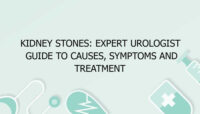Polio in Children: Symptoms, Causes, and Treatment
Polio, or poliomyelitis, is a highly infectious disease caused by the poliovirus. It primarily affects children, leading to a range of symptoms from mild to severe, and can have lasting impacts on health and development. The disease has been largely controlled in many parts of the world due to extensive vaccination programs, but understanding polio in children remains crucial for ensuring continued protection and awareness. This comprehensive article delves into the symptoms, causes, and treatment of polio in children, offering a detailed overview of this significant health issue.
Understanding Polio in Children
Polio in children is a serious illness caused by the poliovirus, which affects the central nervous system. The virus is highly contagious and can lead to a range of symptoms, from mild flu-like signs to severe paralysis. While polio has been eradicated in many regions due to vaccination efforts, the disease remains a concern in areas where vaccination coverage is insufficient.
Types of Polio
Polio can be classified into three main types based on the severity of the illness:
1. Abortive Polio:
Abortive polio is the mildest form of the disease, characterized by symptoms that resemble those of a common viral infection. These symptoms may include fever, sore throat, and headache. In most cases, children with abortive polio recover fully without complications.
2. Nonparalytic Polio:
Nonparalytic polio, also known as aseptic meningitis, involves symptoms similar to abortive polio but with additional signs of meningitis, such as stiffness in the neck and back. This form of polio can cause more severe discomfort and may require medical attention, but it does not lead to permanent paralysis.
3. Paralytic Polio:
Paralytic polio is the most severe form of the disease and can result in permanent paralysis. This type of polio affects the motor neurons in the spinal cord, leading to muscle weakness and paralysis. It can cause significant disability and, in severe cases, respiratory problems that may be life-threatening.
Symptoms of Polio in Children
The symptoms of polio in children can vary depending on the form of the disease. In general, the initial symptoms may be mild and flu-like, but they can progress to more severe manifestations.
1. Initial Symptoms:
- Fever: A high fever is often one of the first signs of polio. It can be accompanied by chills and sweating.
- Fatigue: Children with polio may feel unusually tired and weak. This fatigue can be generalized or localized to specific muscle groups.
- Sore Throat: A sore throat is common and may be accompanied by discomfort when swallowing.
- Headache: Persistent headaches are a common symptom and can be severe in some cases.
2. Progression to Severe Symptoms:
- Neck Stiffness: In cases of nonparalytic polio, children may experience stiffness in the neck and back, indicating inflammation of the meninges (the protective covering of the brain and spinal cord).
- Muscle Weakness: Paralytic polio leads to muscle weakness and can affect various muscle groups. This weakness often starts in the legs but can also involve the arms and trunk.
- Paralysis: The most severe symptom of paralytic polio is muscle paralysis. This can start as weakness or flaccid paralysis (limp muscles) and may progress to more extensive paralysis. The paralysis is typically asymmetrical, affecting one side of the body more than the other.
- Respiratory Issues: In severe cases of paralytic polio, respiratory muscles can be affected, leading to difficulty breathing and potentially requiring mechanical ventilation.
Causes of Polio in Children
Polio is caused by the poliovirus, which is transmitted from person to person through the fecal-oral route or, less commonly, through respiratory droplets. Understanding the transmission and causes of polio is essential for preventing the disease and protecting public health.
1. Transmission:
- Fecal-Oral Route: The most common mode of transmission is through ingestion of contaminated food or water. The virus is present in the feces of an infected person and can spread if proper hygiene and sanitation practices are not followed.
- Respiratory Droplets: Although less common, polio can also be spread through respiratory droplets from coughs or sneezes of an infected person.
2. Viral Replication:
- Infection of the Gut: Upon ingestion, the poliovirus initially infects the throat and gastrointestinal tract. It multiplies in the intestines and can invade the bloodstream.
- Spread to the Nervous System: In some cases, the virus can spread from the bloodstream to the central nervous system, where it attacks motor neurons in the spinal cord. This can lead to the characteristic muscle weakness and paralysis associated with polio.
3. Risk Factors:
- Unvaccinated Individuals: Children who have not been vaccinated are at a higher risk of contracting polio. Vaccination is the most effective method for preventing the disease.
- Poor Sanitation: Areas with poor sanitation and hygiene practices are more susceptible to outbreaks of polio, as the virus spreads more easily in such environments.
- Travel to Endemic Areas: Traveling to regions where polio is still prevalent increases the risk of exposure to the virus.
Diagnosis of Polio in Children
Diagnosing polio in children involves a combination of clinical evaluation, laboratory tests, and imaging studies. Accurate diagnosis is crucial for appropriate treatment and management.
1. Clinical Evaluation:
- Medical History and Symptoms: The healthcare provider will take a detailed medical history and assess the child’s symptoms, including any recent travel or exposure to individuals with polio.
- Physical Examination: A physical examination will focus on evaluating muscle strength, reflexes, and signs of paralysis. The provider will also look for symptoms of meningitis, such as neck stiffness.
2. Laboratory Tests:
- Virus Isolation: Poliovirus can be isolated from stool samples, throat swabs, or cerebrospinal fluid (CSF) using cell culture techniques. This confirms the presence of the virus in the body.
- Polymerase Chain Reaction (PCR): PCR testing can detect viral RNA in respiratory or fecal samples. It is a sensitive and specific method for identifying the poliovirus.
- Serology: Blood tests can detect antibodies to the poliovirus, indicating past infection or exposure.
3. Imaging Studies:
- MRI and CT Scans: In cases of severe neurological involvement, imaging studies such as magnetic resonance imaging (MRI) or computed tomography (CT) scans may be used to assess damage to the spinal cord or brain.
Treatment of Polio in Children
Treatment for polio in children focuses on managing symptoms, preventing complications, and supporting recovery. There is no specific antiviral treatment for polio, so management is largely supportive.
1. Symptomatic Treatment:
- Pain and Fever Management: Over-the-counter pain relievers and antipyretics, such as acetaminophen or ibuprofen, can help manage pain and reduce fever.
- Muscle Relaxants: Muscle relaxants may be prescribed to alleviate muscle spasms and stiffness.
2. Supportive Care:
- Physical Therapy: Physical therapy is essential for helping children with muscle weakness or paralysis regain as much function as possible. Rehabilitation exercises can improve mobility and strength.
- Respiratory Support: In severe cases where respiratory muscles are affected, mechanical ventilation or other respiratory support may be required.
- Orthotic Devices: Children with limb paralysis may benefit from the use of braces or other orthotic devices to support affected limbs and improve mobility.
3. Preventive Measures:
- Vaccination: The most effective way to prevent polio is through vaccination. The inactivated poliovirus vaccine (IPV) is administered in a series of doses during infancy and early childhood. The oral poliovirus vaccine (OPV) is used in some countries, but IPV is preferred in areas where polio is being eradicated.
4. Long-Term Management:
- Ongoing Care: Children who recover from polio may require long-term follow-up and ongoing care to manage any residual effects or complications. This may include regular check-ups with healthcare providers and continued physical therapy.
Prevention of Polio in Children
Preventing polio is primarily achieved through vaccination and public health measures. Vaccination has been instrumental in reducing the incidence of polio worldwide and is key to continuing progress towards eradication.
1. Vaccination Programs:
- Inactivated Poliovirus Vaccine (IPV): IPV is administered through injections and is used in many countries. It is highly effective in preventing polio and does not carry the risk of vaccine-associated paralytic poliomyelitis (VAPP).
- Oral Poliovirus Vaccine (OPV): OPV is administered orally and has been used extensively in polio eradication campaigns. It provides robust immunity but carries a small risk of VAPP. OPV is still used in some countries where polio is endemic.
2. Public Health Measures:
- Improved Sanitation: Ensuring access to clean water and proper sanitation helps reduce the spread of the poliovirus and prevents outbreaks.
- Health Education: Public education about hygiene practices, vaccination, and disease prevention is essential for controlling the spread of polio.
- Surveillance: Active surveillance for cases of polio and monitoring vaccination coverage are critical for identifying outbreaks and ensuring timely responses.
FAQs
What is polio in children, and how does it affect them?
Polio in children is a viral infection caused by the poliovirus that primarily affects the central nervous system. It can lead to a range of symptoms, from mild flu-like signs to severe muscle weakness and paralysis. In severe cases, polio can cause respiratory difficulties and long-term disability. The impact of polio depends
on the severity of the infection and the extent of neurological involvement. While the disease has been largely controlled through vaccination, understanding its effects remains crucial for prevention and treatment.
What are the common symptoms of polio in children?
Common symptoms of polio in children include fever, sore throat, headache, and fatigue, similar to those of a mild viral infection. As the disease progresses, symptoms can become more severe, including neck stiffness, muscle weakness, and paralysis. In cases of paralytic polio, muscle paralysis may occur, affecting the legs, arms, and respiratory muscles. The severity and specific symptoms can vary depending on the form of polio and the extent of neurological involvement.
What causes polio in children?
Polio in children is caused by the poliovirus, which spreads through the fecal-oral route or respiratory droplets. The virus enters the body through ingestion of contaminated food or water or through close contact with an infected person. Once ingested, the virus replicates in the gastrointestinal tract and can spread to the central nervous system, leading to inflammation and damage to motor neurons in the spinal cord. This can result in muscle weakness and paralysis.
How is polio in children diagnosed?
Diagnosing polio in children involves a combination of clinical evaluation, laboratory tests, and imaging studies. Healthcare providers assess symptoms, medical history, and perform physical examinations to identify signs of polio. Laboratory tests, including virus isolation, PCR testing, and serology, confirm the presence of the poliovirus. Imaging studies like MRI or CT scans may be used to assess neurological damage. Accurate diagnosis is essential for determining the appropriate treatment and management.
What are the treatment options for polio in children?
Treatment for polio in children focuses on managing symptoms, preventing complications, and supporting recovery. There is no specific antiviral treatment for polio, so management is supportive. This includes pain and fever management with medications, physical therapy to improve muscle strength and mobility, and respiratory support if needed. Long-term care may involve ongoing physical therapy and the use of orthotic devices to assist with mobility. Vaccination remains the primary method of prevention.
How can polio in children be prevented?
Polio in children can be prevented through vaccination, which is the most effective method for controlling the disease. The inactivated poliovirus vaccine (IPV) is administered in a series of doses during infancy and early childhood. Public health measures such as improved sanitation, health education, and active surveillance also play a crucial role in preventing polio. Ensuring high vaccination coverage and timely administration of vaccines helps protect children and reduce the risk of outbreaks.
What are the possible complications of polio in children?
Complications of polio in children can include residual muscle weakness, paralysis, and respiratory difficulties. In severe cases, polio can lead to long-term disability and the need for ongoing medical care. Complications may also involve joint deformities, muscle atrophy, and complications related to respiratory support. Early diagnosis and treatment are crucial for managing complications and improving outcomes. Continued follow-up and rehabilitation may be necessary for children who experience significant effects from the disease.
When should I seek medical attention for my child’s symptoms?
Medical attention should be sought if a child exhibits symptoms of polio, such as persistent fever, severe headache, neck stiffness, or muscle weakness. Immediate care is necessary if the child shows signs of paralysis, respiratory distress, or severe discomfort. Prompt medical evaluation is important for diagnosing the condition, providing appropriate treatment, and preventing complications. Early intervention can significantly impact the child’s recovery and overall well-being.
Is polio in children contagious?
Polio itself is not directly contagious, but the poliovirus that causes the disease is highly contagious. It spreads through the fecal-oral route or respiratory droplets from an infected person. Good hygiene practices, such as frequent hand washing and proper sanitation, help reduce the risk of transmission. Vaccination is the most effective way to prevent polio and protect individuals from contracting and spreading the virus.
What is the prognosis for children with polio?
The prognosis for children with polio depends on the severity of the disease and the extent of neurological involvement. Many children recover fully from mild forms of polio, such as abortive or nonparalytic polio. However, those with paralytic polio may experience long-term effects, including muscle weakness and paralysis. Rehabilitation and ongoing care can help improve function and quality of life. The overall prognosis is generally positive with early diagnosis and appropriate treatment, though some children may face lifelong challenges.
In summary, polio in children is a serious infectious disease with significant implications for health and development. Understanding the symptoms, causes, and treatment options is essential for effective management and prevention. Vaccination remains the cornerstone of polio prevention, and public health measures are crucial for controlling the spread of the virus. By staying informed and proactive, parents and caregivers can help ensure the health and well-being of children affected by or at risk of polio.


